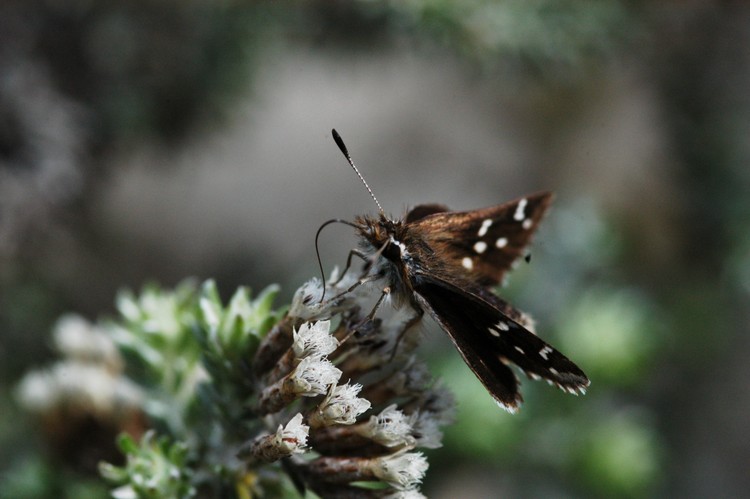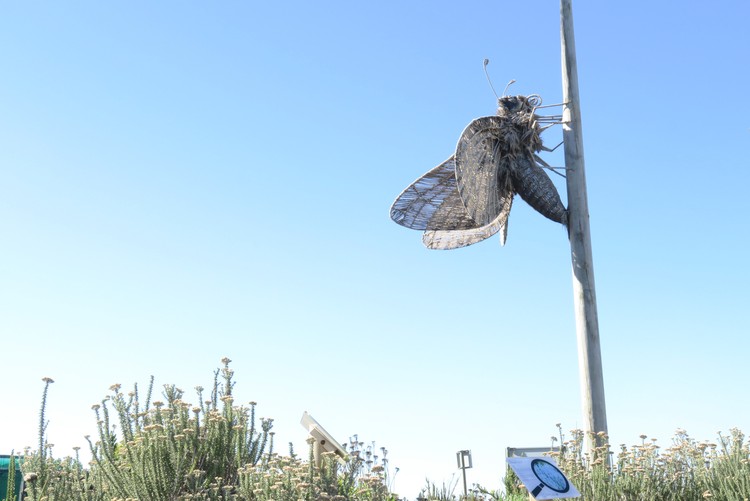Strandfontein development could make critically endangered butterfly extinct
The only colony of one of the world’s most endangered butterflies is within sight of a large, multi-storey development
Barber’s Cape Flats Ranger (Trida barberae bunta), of which there are less than 50 individuals left, survive within one square kilometre of Dune Strandveld in Strandfontein. Photo: Ismat Adams, with permission.
- There are fewer than 50 of Barber’s Cape Flats Ranger butterfly left.
- The butterfly exists in a corner of Dune Strandveld between Baden Powell Drive and Strandfontein Road.
- While the butterfly colony is outside the footprint of an ambitious new multi-storey urban development at the Strandfontein Coastal Park, there are concerns about further habitat encroachment.
- There is currently no management plan to ensure the species does not go extinct.
A large, multi-storey development proposed at Strandfontein could put one of the rarest butterflies in the world at even greater risk of extinction, and decrease biodiversity for which Cape Town is famous.
The City of Cape Town is pushing forward with its plan to create a “coastal urban node” at what is currently the Strandfontein Pavilion, which will include more than 1,000 residential units, retail and recreational facilities, and an aquaponics farm.
But a few hundred metres to the north of the development on the southern side of the intersection of Baden Powell Drive and Strandfontein Road, is a colony of critically endangered butterflies, found nowhere else in the world, of which there are less than 50 individuals left.
The initial Conceptual Development Framework for the development, published in June 2022, has one paragraph mentioning the existence of the colony of butterflies, Barber’s Cape Flats Ranger (Trida barbarae bunta, formerly Kedestes barbarae bunta), which warns that Strandfontein Road cannot be altered because of the butterfly.
The Lepidopterist Society of Africa supplied the consultants tasked with developing the Basic Assessment Report (BAR), Infinity Environmental, with maps showing the existence of the butterfly’s host plant, swordgrass (Imperata cylindrica), found on both sides of Strandfontein Road.
Lepidopterists’ Society of Africa member Dave Edge said the road might have to take a higher volume of traffic if the development goes ahead. He said swordgrass is also a vital part of the lifecycle of the False Bay Unique Ranger (Kedestes lenis lenis), which has a larger overall range than the few hectares occupied by Barber’s Ranger, but is also critically endangered. The Strandfontein Road population is one of the largest still existing of this butterfly.
“Any widening of the southern section of Strandfontein Road between Spine Road and Punt Road will destroy much of the habitat available to both butterflies and bring them closer to extinction,” he said.
The South African National Biodiversity Institute (SANBI) states on its website that “heavier vehicular traffic on the Strandfontein Road, which bisects the main colony, has increased the incidence of specimens being hit and killed by vehicles and the amount of air-borne toxins and pollutants from exhaust fumes being released into the habitat”.
SANBI also noted the increased risk of fire in the area “caused by passing motorists disposing of smouldering cigarette ends”.
A sculpture of the critically endangered Barber’s Cape Flats Ranger butterfly was constructed next to Zandvlei in Muizenberg in 2020 as one of Fynbos LIFE’s life circle gardens, which show what the natural vegetation of the area would look like. In actuality the butterfly is small, with a wingspan of only about 30mm, and is brown with white freckles on its wings. Although it looks more like a moth than a butterfly, it is active in the daytime, as butterflies are. Photo: Steve Kretzmann.
Need to maintain an ecological corridor
Currently, Infinity Environmental’s Pre-application Draft BAR published last month, makes no mention of Barber’s Ranger, as the colony falls outside the development footprint.
But the development will “impact natural ecological processes and increase the risks to the last remaining population” of this critically endangered butterfly, says Nature Connect CEO Anthony Roberts.
Roberts said swordgrass was found within the Dune Strandveld vegetation, and what Dune Strandveld remained, needed to be conserved. Furthermore, the City’s Metropolitan Spatial Development Framework (MSDF) plans to have similar coastal developments at Monwabisi and Mnandi, which are also on this vegetation type.
Roberts says the stretch of Dune Strandveld from Muizenberg to Strand was the last natural vegetation connecting Table Mountain and the Hottentots Holland Mountain chains, providing “essential corridors for flora and fauna”. Functional conservation corridors are “essential in the face of climate change impacts”.
He said South Africa was a signatory of the United Nations’ Convention of Biological Diversity, which had targets that included ensuring at least 30% of coastal areas, particularly those important for biodiversity and ecosystem functions and services, were conserved by 2030.
Signatories are also committed to halting “human induced extinction of known threatened species” and to “significantly reduce extinction risk”.
Yet, said Roberts, South Africa had failed to protect the minimum 30% of Dune Strandveld, which was a City failure, as it fell within the municipal area. “A great deal of False Bay Dune Strandveld has been destroyed and any remaining patches should be secured at all costs,” he said.
“The sad thing is that there is still a surprising amount of fauna that still utilise this strip for movement, such as caracal, grysbok, porcupines, genet, mongoose. They have also recently found increased honey badger activity on Table Mountain and there is a good chance these animals have come in along this coastal strip.”
A 2017 report by Stellenbosch University Distinguished Professor Michael Samways on the conservation of biodiversity in and around Cape Town, states the loss of biodiversity and ecosystem function is a “major concern worldwide”, and such losses were likely to be “particularly acute” in Cape Town as it was part of a global biodiversity hotspot.
“Furthermore, the Cape Flats Dune Strandveld faces a high level of threat, with certain vegetation subtypes highly threatened and urgently in need of protection,” states Samways.
Further studies needed
Cape Nature land-use scientist Ismat Adams, who has written a Master’s thesis on the Barber’s Ranger, recommended a specialist determine whether swordgrass occurs on the development site, and if it does, a butterfly assessment should be done. This would determine whether “no-go areas” should be established.
Adams said the Barber’s Ranger did not move far within its environment so if none of the host plant were on the development site, it would be “unlikely” any of the butterflies would be there in search of nectar sources, “especially considering the habitat fragmentation and dispersal barriers presented by the main roads of Spine Road and Baden Powell”.
Cape Town Deputy Mayor and Mayco Member for Spatial Planning and Development Eddie Andrews said the existing colony of Barber’s Ranger was outside the development area.
“The population referenced in the comment occurs north of Baden Powell Drive while the proposed Strandfontein Coastal Urban Node occurs south of Baden Powell Drive. This is a considerable distance (approximately 1km) outside of the proposed site boundaries and the proposed development is, therefore, not anticipated to impact the habitat of the butterflies,” said Andrews.
He said comments received from the Lepidopterists’ Society of Africa highlighted concerns about widening Baden Powell Drive to accommodate additional traffic to the development. “This concern is noted and will likely form part of considerations if and when Baden Powell Drive is widened in future,” he said.
Lack of protection
Roberts said Nature Connect, which was then the Cape Town Environmental Trust, were involved in a three-year conservation project for the Barber’s Ranger from 2018 to 2020 in collaboration with the City. He said the project had been funded by the Mohamed bin Zayed Foundation and the Brenton Blue Trust, but when funding from Leisure Charitable Trust, which funded the project manager, came to an end the project had to be shelved.
He said they tried to breed the Barber’s Ranger in a controlled environment but were unsuccessful. As there were so few individuals left in the wild, removing more to continue the breeding efforts would impact the remaining population, so they shifted to breeding the Cape Flats Ranger, which have a wider distribution. He said they had “some success” with that.
Although the City’s own Biodiversity Report of 2018 states there is a need to protect biodiversity, and conserve threatened species, Adams said he was not aware of any current management plan for the Barber’s Ranger.
Our question as to what the City was doing to ensure the continued existence of Barber’s Ranger did not receive a response.
Support independent journalism
Donate using Payfast

Don't miss out on the latest news
We respect your privacy, and promise we won't spam you.
Next: Councillor denies giving people permission to occupy land in Johannesburg
Previous: Sex workers picket at Parliament ahead of elections
Letters
Dear Editor
I hereby support all measures possible to protect the threatened barber butterfly at Strandfontein by the new housing and building development there. Please preserve its habitat grass and set out a protected area in the dunes in the interests of conservation of our precious natural biodiversity
© 2024 GroundUp. This article is licensed under a Creative Commons Attribution-NoDerivatives 4.0 International License.
You may republish this article, so long as you credit the authors and GroundUp, and do not change the text. Please include a link back to the original article.
We put an invisible pixel in the article so that we can count traffic to republishers. All analytics tools are solely on our servers. We do not give our logs to any third party. Logs are deleted after two weeks. We do not use any IP address identifying information except to count regional traffic. We are solely interested in counting hits, not tracking users. If you republish, please do not delete the invisible pixel.


